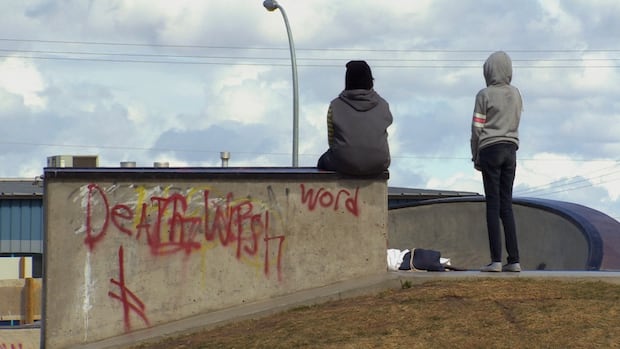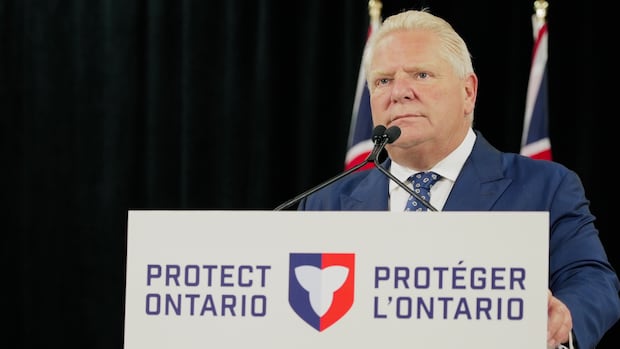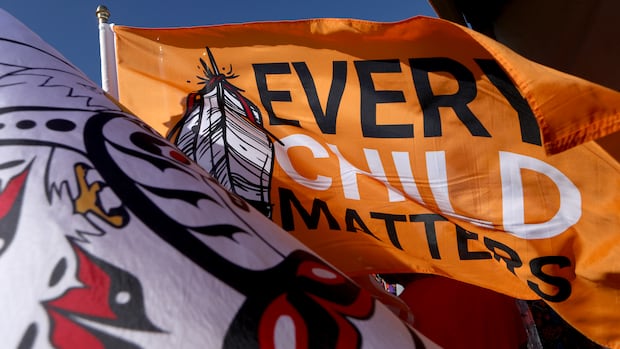WARNING: This story contains details of suicide and self-harm.
An investigation into the suicide deaths of four teens in Alberta warns that fear of the child welfare system among Indigenous families is a dangerous barrier to care for First Nations children in crisis.
The public fatality inquiry, led by Judge Danielle Dalton in October 2022, investigated the deaths of four young people from Maskwacis and its four First Nations communities between 2017 and 2020.
Dalton’s 44 recommendations, if followed, would alter how Alberta’s child welfare system determines when a minor is in need of intervention, secure new mental health supports for Indigenous children in crisis and institute new programs to carefully track the death toll.
None of the various government and health agencies named in the report have filed formal responses to the recommendations.
In a statement to CBC News, Alberta’s Ministry of Children and Family Services said it is reviewing the report and will provide a response in the fall.
“It is critical for work to continue to connect Indigenous children and youth to their families, communities and culture, in partnership with Indigenous communities,” the statement reads.
“The work to strengthen cultural supports and connections with community for those who need child intervention services is continuing.”
Identified in the report by only their initials, the teens, aged 15 to 19, had all come into contact with the child welfare system but none were in care at the time of their deaths.
C.L., 15, a member of Samson Cree First Nation, died at home after a young life marred by family tragedies that resulted in the death of her sister and brother and separated her from the mother she had always known.
At 19, T.M., a member of the Louis Bull First Nation, had endured relentless childhood domestic abuse that left her struggling to cope with crippling depression that took hold following the birth of her baby girl.
The girls were found dead on the same day, December 19, 2017.
S.R. and and E.S., of Montana Cree Nation, were siblings. Described as smart and kind-hearted, they shared a close bond.
S.R. died in May 2017 at age 15 after years of sexual abuse and a vicious assault in a group home.
E.S., increasingly isolated by the pandemic and traumatized by having found his sister in her final moments, took his own life in April 2020 at 16.
‘Still in crisis’
The deaths are part of a string of suicides that plagued the community for decades, said Randy Littlechild, Maskwacis Health Services CEO, a community health centre that provides counselling and around-the-clock mental health crisis response care within the central Alberta reserve communities.
Littlechild said the number of suicides has declined in recent years as more mental health supports became available. But as the number of suicides has waned, deadly overdoses have escalated, he said.
“They’ve just gone from a mental health crisis to wanting some relief… But it’s not curing them at all. It’s hurting them more.”
Littlechild said there is a sense of hopelessness among many Maskwacis youth. Issues of extreme poverty and isolation are compounded by grief and the legacy of residential schools.
“The community is still in crisis.”
In her findings, released earlier this month, Dalton makes recommendations aimed at dismantling barriers to care while reaffirming previous calls to address the high number of Indigenous children dying in care.
Dalton said examining the four suicides through a combined investigation was an unusual step but meant the deaths could be understood, not as anomalies, but as part of a larger crisis that continues to unfold in First Nation communities.
“It may be fanciful and even hubris to think that this report will move the dial,” she wrote.
“But I am convinced that this process is nevertheless an important one, if for no other reason than to shine a light on this ongoing tragedy.”
Prevention over intervention
The report highlights a significant barrier in the provincial child welfare system: the requirement that a child must be deemed “in need of intervention” for services to be provided.
The legal threshold often forces parents to admit to “unwillingness or inability” to care for their child before intervention services can be provided.
This approach compounds a deep-seated distrust of child protection services within Indigenous communities, Dalton wrote.
Residential schools and the Sixties Scoop saw generations of Indigenous children forcibly removed from their families and that trauma continues to reverberate.
Read more about the lives of the young sister and brother who both died by suicide, years apart:
Dalton calls on the Alberta government to amend the Child, Youth and Family Enhancement Act to allow Indigenous youth in immediate danger to access secure services on a voluntary, preventive basis without needing to meet the “in need of intervention” threshold.
She also calls for changes that would ensure Indigenous youth with significant mental health issues can access services, without requiring a finding of parental neglect.
“State intrusion into the life of the family should only be done when necessary,” Dalton wrote.
“At the same time, the threshold for state intervention – even if a guardian is seeking help – may be unacceptably high.”
The current laws force guardians into a dilemma — seek help and risk losing a child or refuse help and face potential harm.
A fear of child welfare services was evident in all three families affected by the suicides, Dalton found. In C.L.’s case, facing apprehension from their family’s care, she and her brothers ran away twice.
The distrust was most stark in the case of S.R., Dalton wrote.
She started self-harming two years before her death. Her mother, desperate to keep her safe, eventually surrendered custody of S.R. to a group home in the hope she could better supports.
Soon after, S.R. suffered an assault in the group home that resulted in life-altering injuries.
She returned home but was afraid to go outside and stopped attending school. She died the following year.
‘Ticking clock’
Along with altering the critical threshold for intervention, Dalton called for changes that would remove the “ticking clock” from child welfare services.
Under current Alberta legislation, there are timelines for when a child removed from family custody must be placed under a permanent guardianship order.
The total time during which a child is in the care of a director can not exceed nine months if the child is under the age of six —12 months if the child is older.
The act of taking a youth into care starts the clock ticking toward permanency and possibly losing a child forever, the fatality inquiry heard.
Read more about two young women who died on the same day and the challenging circumstances that shaped their lives:
Cheryl Whiskeyjack, executive director of the Edmonton-based Bent Arrow Traditional Healing Society, which provides mental health supports to Indigenous youth and families, said Indigenous parents worry that accessing services will put them on the system’s radar.
This often leads families to struggle alone until a crisis becomes unmanageable, she said.
“There’s always been that fear from community and it has nothing to do with the line between prevention and intervention. It’s a fear of the system.”
She said the focus should be on ensuring First Nations children can remain within their families through kinship care placements to maintain their connection to community and heritage.
“The colonial history, it’s fractured the family system.”
Suicide contagion
Dalton’s recommendations also focused on mitigating the risk of suicide contagion.
When a young person dies by suicide in a tight-knit Indigenous community, the impact of their death is profound and it’s not uncommon for a suicide to be followed by another.
In order to stem the dangerous phenomenon, Dalton recommends the development of targeted grief supports for Indigenous youth who have lost someone to suicide, and that funding for these programs be made a priority.
Healing is needed throughout the community.– Peyasy Wuttunee
Suicide contagion and grief were evident in each of the deaths, the inquiry heard. Each of the teens were dealing with the recent death of a loved one or a person close to them.
Peyasu Wuttunee, manager of Maskwacis Health Services, told the inquiry, that grief is perhaps the biggest challenge that the community faces in trying to decrease the risk of suicide.
“It is not just money that will address the issues,” he testified. “Healing is needed throughout the community.”
Power struggle, data void
Dalton also called for changes to address what she characterized as a critical lack of co-operation among the complex framework agencies responsible for caring for First Nation children in crisis.
Agencies must work together to prevent a “power struggle” between jurisdictions and ensure First Nations can access specialized services they may not be able to provide themselves, she wrote.
A void of data collection was also highlighted. Suicide is among the leading causes of death among Indigenous youth but the extent of the crisis within reserve communities remains untracked, Dalton wrote.
The province’s Children and Family Services and Alberta Health do not collect Indigenous-specific data on youth suicide. Dalton said that must change to ensure resources are deployed where they’re needed most.
She said service providers must also develop information-sharing protocols to ensure that all relevant parties have the details needed on a child’s history to provide effective care.
Dalton’s report also acknowledges the power of cultural identity as a means to protect Indigenous youth.
She recommended that governments continue to target funding toward community-led programming, entrusting First Nation communities to serve the needs of their own children.
Littlechild echoed those calls. Restoring tradition will provide the next generation strength and purpose, he said.
“That cultural awareness that was never brought down to the children, it’s now starting to come back.
“They’re starting to see and understand their own culture and understand how valuable life is.”

If you or someone you know is struggling, here’s where to look for help:







